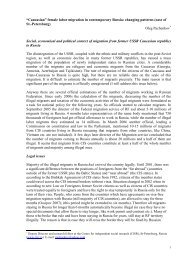THORIUM AS AN ENERGY SOURCE - Opportunities for Norway ...
THORIUM AS AN ENERGY SOURCE - Opportunities for Norway ...
THORIUM AS AN ENERGY SOURCE - Opportunities for Norway ...
You also want an ePaper? Increase the reach of your titles
YUMPU automatically turns print PDFs into web optimized ePapers that Google loves.
Thorium Resources in <strong>Norway</strong><br />
The thorium concentration in the Fen rocks is positively correlated with iron (Fe) [12]. Thus, the<br />
white carbonate part of the Complex has low levels of thorium. The summary report from<br />
previous investigations concluded that the thorium concentrations are:<br />
• 0.4 wt% thorium in the iron ore.<br />
• 0.2 - 0.3 wt% thorium in enriched zones in the iron-rich part of the ore.<br />
• 0.13 - 0.17 wt% thorium in the iron-rich part in large volumes.<br />
As shown in Table 3.1, the concentration of thorium (Th-232) is highest in rauhaugite and<br />
rødberg [15]. The iron-rich part of the carbonatite, rødberg, was mined <strong>for</strong> iron from 1655 until<br />
1927, and søvite was mined <strong>for</strong> niobium (Nb) between 1953 and 1965. The carbonate rock has also<br />
been investigated <strong>for</strong> exploitation of phosphorus (P). Many pits and piles of tailings in the Fen<br />
Complex reflect the previous extensive mining activities. Today, about 350 dwellings are located<br />
within the Fen Central Complex.<br />
Table 3.1: Activity Concentration of Thorium-232 (Th-232) in Rock Samples from the Fen Complex.<br />
4 Bq/kg (Becquerel 1 /kg) Th-232 is Equivalent to 1 ppm Th.<br />
Rock Type<br />
Number of<br />
Samples<br />
Th-232<br />
(Bq/kg)<br />
Mean Range<br />
Rödberg 9 3100 (390 - 5900)<br />
Rauhaugite 9 600 (290 - 930)<br />
Sövite 9 80 (20 - 190)<br />
Fenite 8 130 (20 - 200)<br />
Precambrian<br />
Gneiss<br />
3<br />
66 (68 - 63)<br />
Based on recent helicopter surveys made by the Geological Survey of <strong>Norway</strong> [16] using a large<br />
NaI (Sodium Iodide) scintillator detector to detect the gamma radiation from the area, the<br />
distribution of thorium in the upper soils and bedrocks of the Fen Complex has been identified<br />
(Figure 3.2). Although thorium in deeper mineral deposits will not be included in the gamma<br />
measurements, the map shown in Figure 3.1 corresponds well with the distribution of rødberg in<br />
the bedrock of Fen. However, uranium is also present in a series of minerals present in the Fen<br />
Complex. Based on the helicopter survey where gamma radiation was determined, gamma<br />
energies from the Th-232 series and from the U-238 series could be differentiated. Thus,<br />
in<strong>for</strong>mation of the distribution of uranium in the upper soils and bedrocks of the Fen Complex has<br />
also been obtained (Figure 3.3). Thus, traces of thorium-234 (Th-234), being a daughter of U-238<br />
will also be present in the minerals. The distribution of thorium and uranium seems to correlate<br />
well, which indicates that uranium and its daughters will be present in the raw materials and the<br />
waste when mining and extraction of thorium is per<strong>for</strong>med.<br />
1 Radiation Emitted from a Source: Desintegration per Second = Becquerel (Bq)<br />
25

















